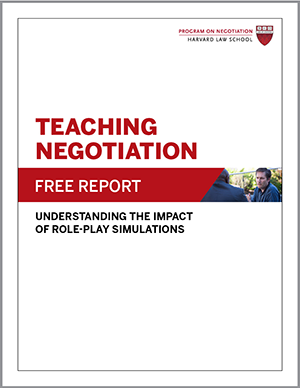
Avoid cross-cultural misunderstandings with these negotiation exercises
It’s no secret that communication and negotiation etiquette varies widely across cultures. In France, for example, it is rude to talk money over dinner, while in Brazil the American ‘A-OK’ gesture (thumb and forefinger forming a circle) can be a major insult.
The increasingly diverse and global nature of business sets the stage for disputes that can cross ethnic and cultural lines—fueling the need for expertise in cross-cultural negotiations. Understanding when, where, how, and with whom it is appropriate to negotiate is extremely important when working across cultures. Negotiators and mediators must understand the cultural norms of other parties, especially when they differ from their own.
To help teach these nuances and tactics, the Teaching Negotiation Resource Center (TNRC) has developed several negotiation exercises that address the challenges that are inherent to cross-cultural negotiations.
Two of the TNRC’s most useful negotiation exercises for learning how to manage cross-cultural negotiations are Hiring a Newtonian and Pacrim Dispute.
Hiring a Newtonian – Featured Negotiation Exercises
A human resources director has been tasked with hiring a computer programmer, a recent immigrant from Newtonia who won’t accept the position until certain requirements are met.
However, the Newtonian believes that he cannot disclose the specific requirements without invoking bad luck. He also has other cultural expectations of how the human resources director should behave in order to comfortably transact business. This interesting exercise allows participants to:
- Examine the hidden nature of cultural issues in negotiation
- Explore ways to deal with the difficulty of not fully understanding your counterpart’s interests
- Gain a better understanding of a negotiator’s cultural preferences
Pacrim Dispute – Featured Negotiation Exercises
When people from high-context and low-context cultures sit down to negotiate, they must understand each other’s “cultural baggage” in order to have a chance to reach agreement. This tri-party negotiation exercise examines the cultural roadblocks that can prevent parties from reaching agreement. In this dispute over trading rice, participants examine the roles that mindset and culture play in reaching agreements, by:
- Identifying problems that can occur when people from different societies negotiate
- Considering different ways of seeing a dispute
- Engaging in the dynamics of a three-party negotiation
- Exercising creative thinking, option generating, and problem solving
- Demonstrating the benefits of a win-win cooperative agreement
- Working through cultural barriers
Do you teach negotiation to students from different cultural backgrounds?
Are you teaching students how to negotiate in a cross-cultural context? Do you teach a “one world” model of negotiation; or, are there cultural variables that require changes in the basic model of negotiation that you teach?
The Program On Negotiation at Harvard Law School invited three members of its highly experienced negotiation faculty to share insights and lessons about how to negotiate and teach, in various cross-cultural contexts.
In this enlightening video Jeswald Salacuse, Eileen Babbitt and David Fairman speak openly as they:
- Explore culture and context: how does each affect the other?
- Describe carefully honed teaching techniques and negotiation exercises.
- Divulge personal challenges they faced in their practice and in their classrooms.
Here’s a brief sample:
Jeswald Salacuse is Henry J. Braker Professor of Law at the Fletcher School of Law and Diplomacy, Tufts University, and served as the Fletcher School’s Dean for nine years.
Eileen Babbitt is Professor of Practice of International Conflict Management, Director of the Institute for Human Security, and Co-Director of the Program on Human Rights and Conflict Resolution at The Fletcher School.
David Fairman is Managing Director at the Consensus Building Institute, Associate Director of the MIT-Harvard Public Disputes Program, and former Lecturer in MIT’s Department of Urban Studies and Planning.
Larry Susskind, vice-chair of PON, moderates the discussion, including a Q&A session at the end of each presentation. He also hosts a captivating interview with the three panelists that crystallizes the most valuable take-away lessons from the exchange.
This video is downloadable as a 14-piece series (each segment is between 2-4 minutes in length) or as a single continuous video that includes all segments (total running time is 40 minutes). A single purchase allows customers to download both versions if they so wish.
Take your training to the next level with the TNRC
The Teaching Negotiation Resource Center offers a wide range of effective teaching materials, including
- Over 200 role-play simulations
- Critical case studies
- Enlightening periodicals
- More than 30 videos
- 100-plus books
Most TNRC materials are designed for educational purposes— for use in college classrooms or corporate training settings. TNRC cases and exercises help mediators and facilitators introduce their clients to a process or issue and help individuals who want to enhance their negotiation skills and knowledge.
Role-play simulations introduce participants to new negotiation and dispute resolution tools, techniques and strategies. Videos are also a helpful way of introducing viewers to key concepts, and TNRC books, case studies, and periodicals address the theory and practice of negotiation and conflict management.
Check out all that the TNRC has in store >>
Let us know about your cross-cultural negotiation experiences in the comments.
Originally published in August, 2014.





